The cashew harvest season in Vietnam & around the world

Mục lục
For cashew farmers and those who have spent their youth growing cashew trees, the most precious time is when the cashew harvest season comes. The cashew season brings many interesting things, including a dream about Vietnamese agricultural products. Let me tell you about this story of cashew harvest.
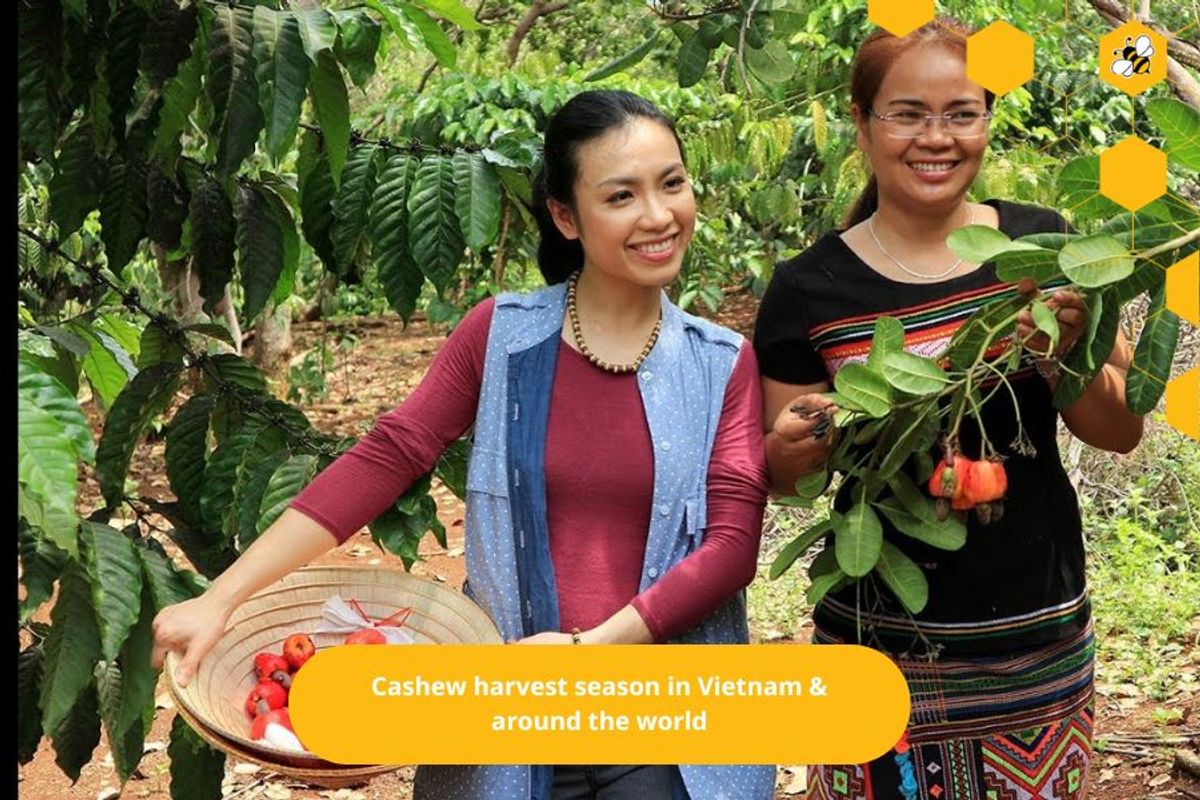
Cashew Harvest Season in Vietnam
The cashew harvest season in Vietnam usually starts in mid-December and lasts until the end of April of the following year. The harvest takes place continuously for about 3 to 4 months.
This is an important time for farmers and cashew enthusiasts because it is when the cashew trees signal that the results of their cultivation have been rewarded with the biggest and most delicious cashews of the year.
The cashew season is also known as the “New Year's Eve moment” for passionate traders or cashew traders.
This is an important time for farmers and cashew enthusiasts because it is when the cashew trees signal that the results of their cultivation have been rewarded with the biggest and most delicious cashews of the year.
The cashew season is also known as the “New Year's Eve moment” for passionate traders or cashew traders.
Remember, to have salted roasted cashews produced all year round, the cashews need to be dried in the sun for about 4 days after harvesting the raw cashews.

Cashew harvest season in the world
Cashews are a famous and popular nutritious nut all over the world, not just in Vietnam.
Up to now, cashews have been grown and produced in more than 32 countries around the world.
India is the country with the largest cashew growing area in the world, followed by Brazil, Vietnam, and African countries such as Ivory Coast, Tanzania, Guinea Bissau, Benin, Nigeria, and Mozambique.
Each country has its own climate and soil characteristics, reflecting different cashew quality.
For countries in the southern hemisphere with a milder climate than the northern hemisphere (such as Kenya, Brazil, and Tanzania), the harvest time usually falls in the fall (around September and October every year).
Meanwhile, in northern hemisphere countries like India and Ivory Coast, harvest time takes place in early winter (November).
Up to now, cashews have been grown and produced in more than 32 countries around the world.
India is the country with the largest cashew growing area in the world, followed by Brazil, Vietnam, and African countries such as Ivory Coast, Tanzania, Guinea Bissau, Benin, Nigeria, and Mozambique.
Each country has its own climate and soil characteristics, reflecting different cashew quality.
For countries in the southern hemisphere with a milder climate than the northern hemisphere (such as Kenya, Brazil, and Tanzania), the harvest time usually falls in the fall (around September and October every year).
Meanwhile, in northern hemisphere countries like India and Ivory Coast, harvest time takes place in early winter (November).
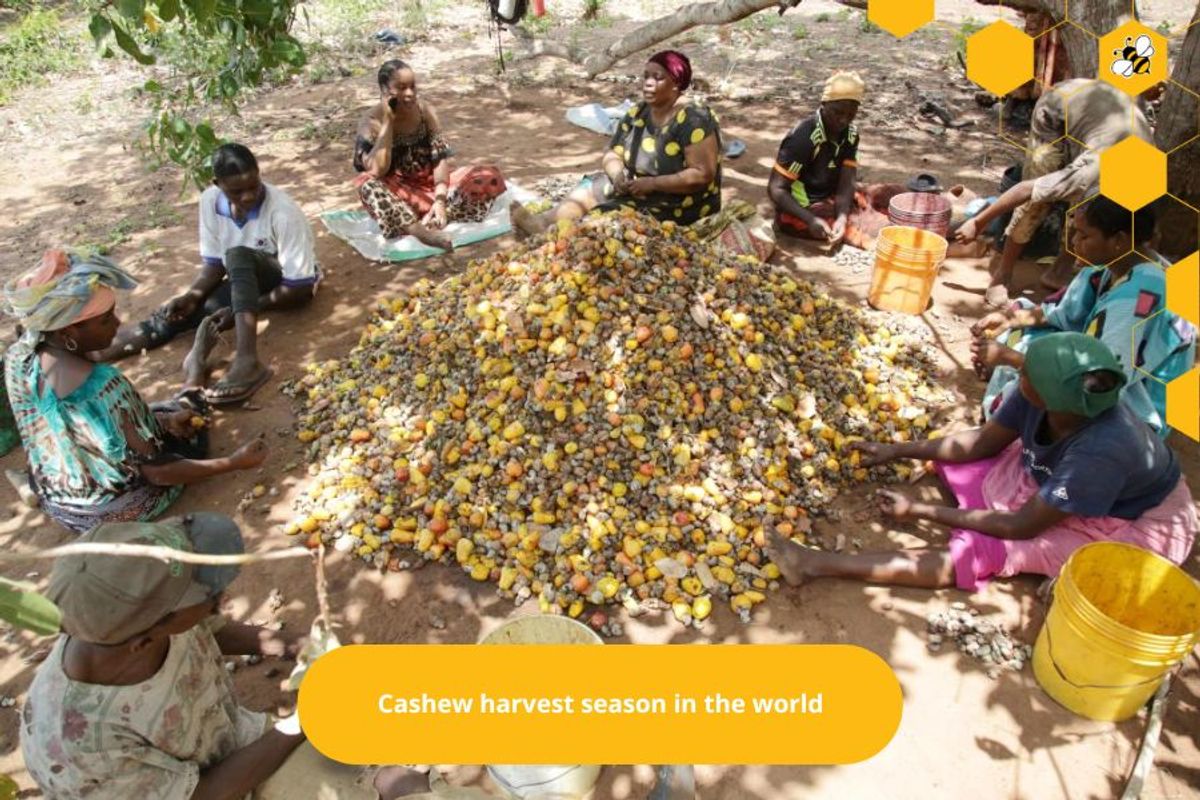
How old is a cashew tree to harvest?
Cashew trees are a type of tree with high economic value, the time from planting to harvesting cashew nuts will take from 2 to 3 years. Cashew trees have a lifespan of up to 40-50 years and usually give stable yields from 10 to 20 years after planting. For cashew trees, from planting to harvesting, it takes about 3 years. However, to have a yield that does not vary from year to year, the cashew tree must be 6 years old or older. Cashew trees are usually about 3m - 9m tall. Cashew leaves grow alternately, are silvery, turn white, and have a light fragrance. Cashew fruit has a delicious taste, along with high food value, so cashew trees soon become popular and become a highly commercial food, can be exported at great value, bringing in a significant economic profit for growers. If you are interested in growing cashew trees, make sure you choose sandy or infertile soil, as cashew trees grow best in these types of soil.
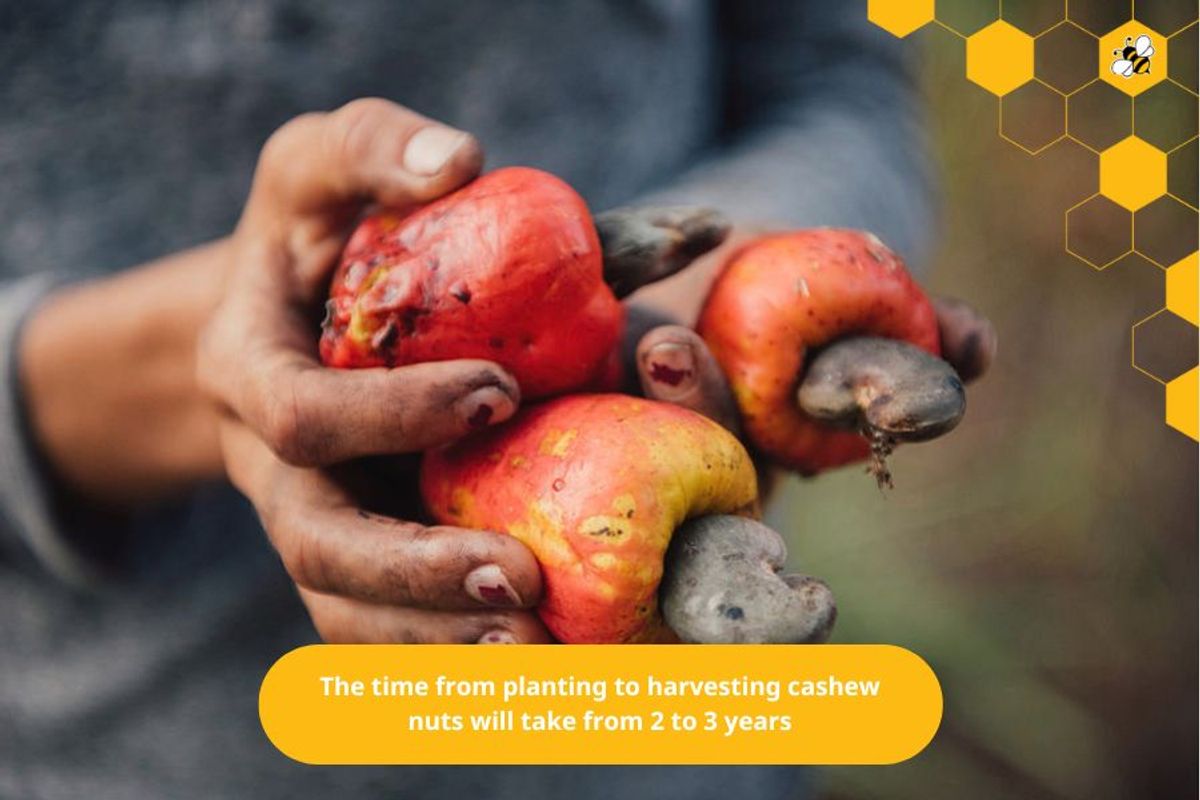
Cashew Harvesting Process
Determine the Ripeness of Nuts and Fruits
To harvest high-quality cashews, you need to distinguish the qualified ripe cashews. Normally, when the cashews are fully ripe, the shell is shiny gray and the fruit is red or pink (depending on the variety), juicy, smooth skin, and has a characteristic fragrant aroma. If you have experience in harvesting cashews, you can see the changes in the shape, color, size, and weight of the seeds.
To determine the ripeness of cashews and fruits, you can follow these instructions:
Color and shell: Ripe cashews usually have shiny gray shells and the fruit is red or pink. The shell should be smooth and not cracked.
Weight and size: Ripe cashews are usually heavier than unripe nuts. The size of the nuts also increases when ripe.
Aromatic: Ripe cashews have a characteristic fragrant aroma. You can smell it to determine the ripeness.
To determine the ripeness of cashews and fruits, you can follow these instructions:
Color and shell: Ripe cashews usually have shiny gray shells and the fruit is red or pink. The shell should be smooth and not cracked.
Weight and size: Ripe cashews are usually heavier than unripe nuts. The size of the nuts also increases when ripe.
Aromatic: Ripe cashews have a characteristic fragrant aroma. You can smell it to determine the ripeness.
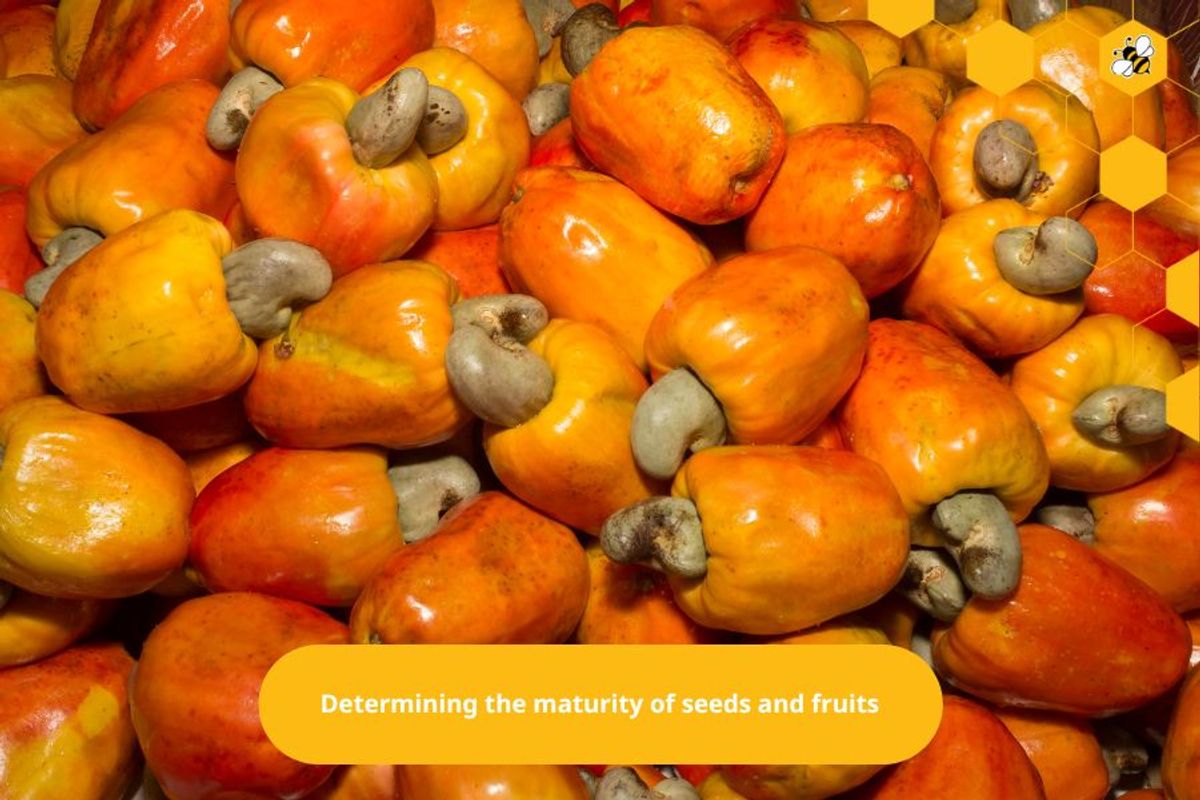
Harvesting methods
The harvesting method of cashew nuts can vary depending on the specific conditions and scale of harvest. Some common methods are:
Hand harvesting:
This is the traditional method and is often used on a small scale.
The harvester will select each ripe cashew nut and cut it off the tree with scissors or a knife.
This method requires a lot of labor and time but helps ensure product quality.
Seedling with automatic cutters:
Automatic cutters can be used on a larger scale.
The machine will automatically cut the ripe cashew nuts from the tree and place them on a bin or conveyor belt.
This reduces time and labor, but it is necessary to ensure that the machine operates efficiently and does not damage the nuts.
Seedling with automatic pickers:
Automatic pickers use robotic arms to pick up the ripe cashew nuts from the tree.
This helps optimize the harvesting process and reduce the impact on the tree.
However, implementing a gripper requires high investment and technical control.
Remember, the choice of harvesting method depends on many factors such as scale, resources, and product quality goals.
Hand harvesting:
This is the traditional method and is often used on a small scale.
The harvester will select each ripe cashew nut and cut it off the tree with scissors or a knife.
This method requires a lot of labor and time but helps ensure product quality.
Seedling with automatic cutters:
Automatic cutters can be used on a larger scale.
The machine will automatically cut the ripe cashew nuts from the tree and place them on a bin or conveyor belt.
This reduces time and labor, but it is necessary to ensure that the machine operates efficiently and does not damage the nuts.
Seedling with automatic pickers:
Automatic pickers use robotic arms to pick up the ripe cashew nuts from the tree.
This helps optimize the harvesting process and reduce the impact on the tree.
However, implementing a gripper requires high investment and technical control.
Remember, the choice of harvesting method depends on many factors such as scale, resources, and product quality goals.
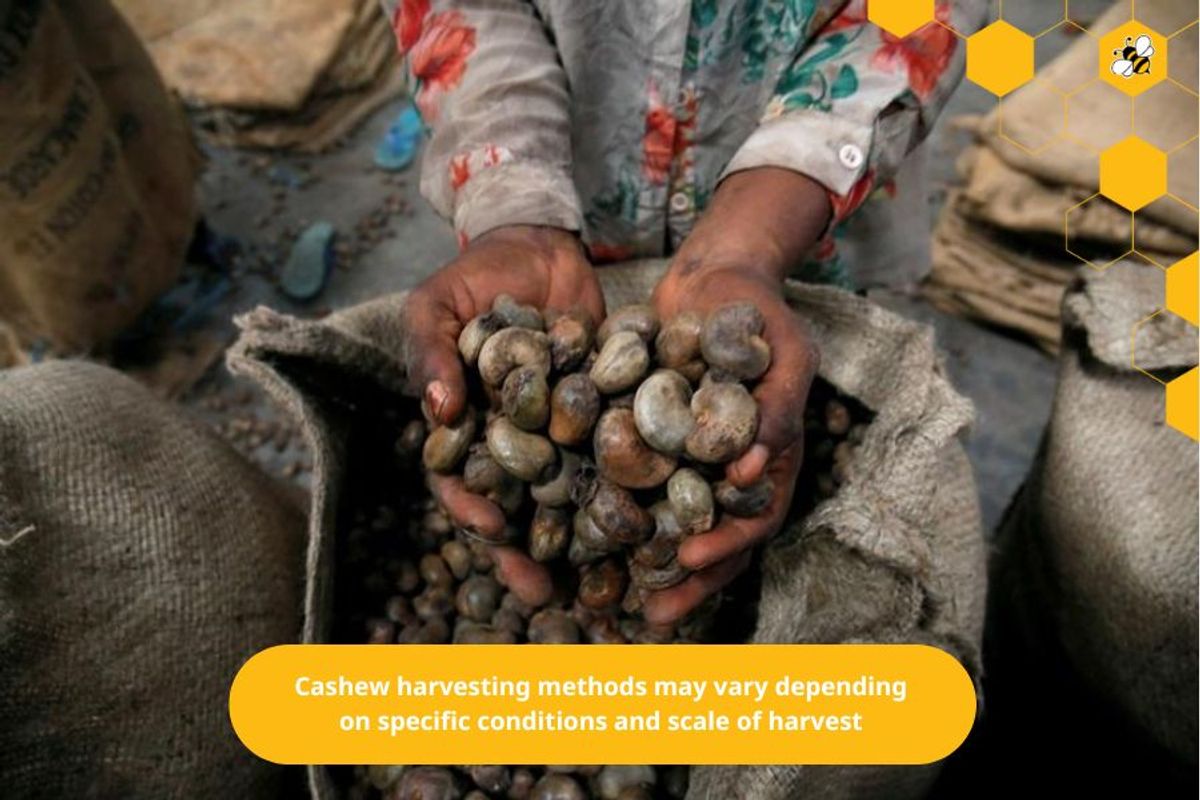
Preserving nuts
After harvesting cashews, preservation is an important factor to ensure the quality and freshness of the product. Here are some instructions on how to preserve cashews after harvesting:
Cleaning cashews:
Clean the flesh stuck to the stem: Remove the flesh stuck to the stem by scraping or cutting.
Washing cashews: Wash cashews with clean water to remove dirt and impurities.
Cleaning cashews:
Clean the flesh stuck to the stem: Remove the flesh stuck to the stem by scraping or cutting.
Washing cashews: Wash cashews with clean water to remove dirt and impurities.
Drying cashews:
Place the cashews in the sun for about 2-3 days to dry.
After drying, sift and basket to remove foreign objects mixed with the cashews.
Preserving dried cashews:
Avoid exposure to high temperatures: Cashews are susceptible to damage if exposed to too high temperatures. Cashews should be stored at room temperature, away from direct sunlight or high temperatures.
Limit exposure to air: Air can cause cashews to become moldy. Always keep the cashew jar tightly closed after use.
Secure packaging:
Cleaning cashews:
Clean the flesh stuck to the stem: Remove the flesh stuck to the stem by scraping or cutting.
Washing cashews: Wash cashews with clean water to remove dirt and impurities.
Cleaning cashews:
Clean the flesh stuck to the stem: Remove the flesh stuck to the stem by scraping or cutting.
Washing cashews: Wash cashews with clean water to remove dirt and impurities.
Drying cashews:
Place the cashews in the sun for about 2-3 days to dry.
After drying, sift and basket to remove foreign objects mixed with the cashews.
Preserving dried cashews:
Avoid exposure to high temperatures: Cashews are susceptible to damage if exposed to too high temperatures. Cashews should be stored at room temperature, away from direct sunlight or high temperatures.
Limit exposure to air: Air can cause cashews to become moldy. Always keep the cashew jar tightly closed after use.
Secure packaging:
Place cashews in a nylon bag or sealed box to avoid exposure to air and light.
Store in a cool, dry place: Avoid storing cashews in humid environments or places with high temperatures.
Preserve processed cashews:
Secure packaging:
Store in a cool, dry place: Avoid storing cashews in humid environments or places with high temperatures.
Preserve processed cashews:
Secure packaging:
After processing (baking, roasting, salting, spicy flavoring, etc.), place the cashews in a sealed box to keep them fresh and delicious.
Avoid direct sunlight: Place cashews in a cool place and avoid direct sunlight.
Shelf Life:
Fresh cashews can be stored for about 6 months to 1 year depending on storage conditions.
Processed cashews have a shorter shelf life, usually ranging from a few weeks to a few months.
Avoid direct sunlight: Place cashews in a cool place and avoid direct sunlight.
Shelf Life:
Fresh cashews can be stored for about 6 months to 1 year depending on storage conditions.
Processed cashews have a shorter shelf life, usually ranging from a few weeks to a few months.
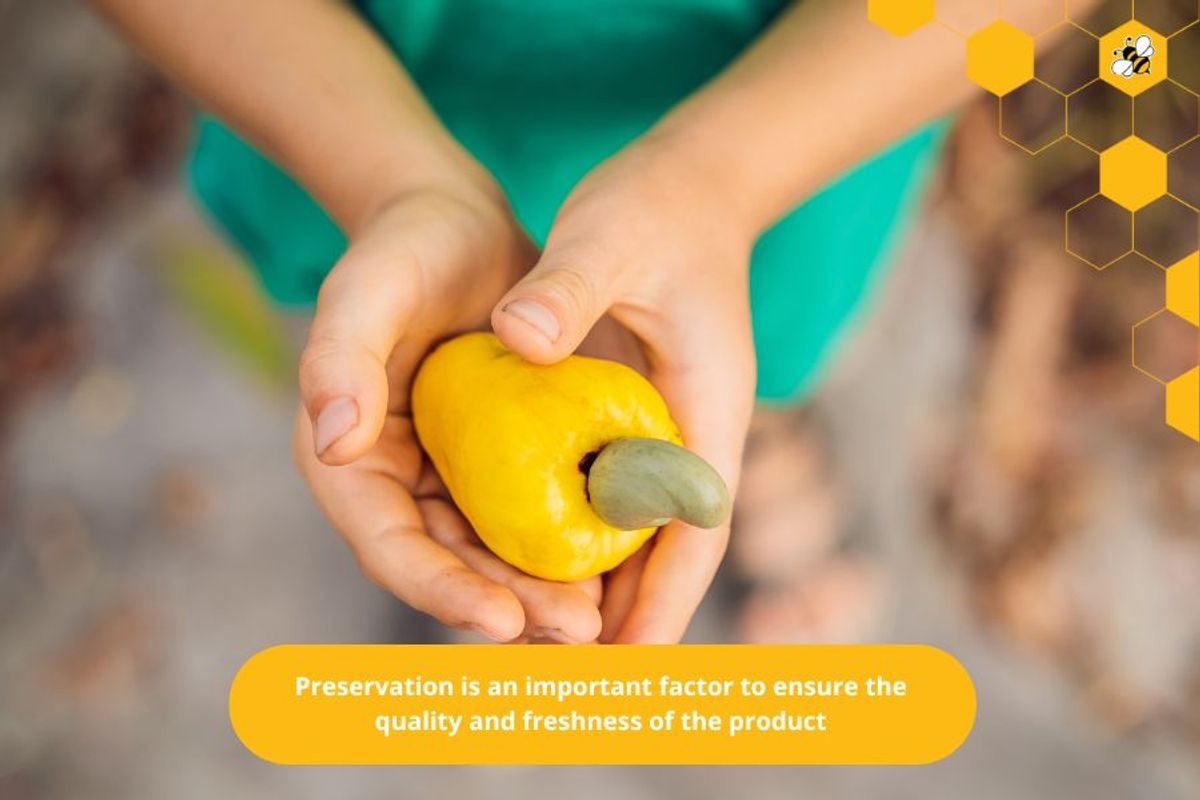
Remember to check the expiration date and follow the preservation measures to ensure that the cashew nuts are always delicious and safe for your health!
Factors affecting the quality of cashew harvest
The cashew harvest season is an important period in agriculture, marking the success of cashew cultivation. Here are some factors that affect the cashew harvest season:
Harvest time:
At the end of the year (according to the Vietnamese lunar calendar) and after Tet (around the middle of the second lunar month), the cashew tree begins to shed flowers and leaves, and the cashew nuts begin to ripen and fall.
If harvested too early, when the fruit is not fully ripe, it can affect the flavor of the cashew nuts later.
Climate and soil characteristics:
Each country has different climate and soil conditions, affecting the quality of cashew nuts.
India is the country with the largest cashew growing area in the world, followed by Brazil, Vietnam, and African countries.
Harvest time depends on the climate and soil conditions of each country.
Cashew growing skills:
Cashew harvesting techniques also affect the quality of the product.
Farmers need to know how to distinguish ripe cashews and harvest at the right time.
Harvest time:
At the end of the year (according to the Vietnamese lunar calendar) and after Tet (around the middle of the second lunar month), the cashew tree begins to shed flowers and leaves, and the cashew nuts begin to ripen and fall.
If harvested too early, when the fruit is not fully ripe, it can affect the flavor of the cashew nuts later.
Climate and soil characteristics:
Each country has different climate and soil conditions, affecting the quality of cashew nuts.
India is the country with the largest cashew growing area in the world, followed by Brazil, Vietnam, and African countries.
Harvest time depends on the climate and soil conditions of each country.
Cashew growing skills:
Cashew harvesting techniques also affect the quality of the product.
Farmers need to know how to distinguish ripe cashews and harvest at the right time.

Remember, the cashew harvest season is not only New Year's Eve for gardeners but also a memorable moment for consumers when enjoying the best cashews of the year.
Conclusion
And finally, when you bite into a cashew, you not only enjoy the sweet taste but also feel the love and effort of the farmers who planted and harvested them. The cashew harvest season is a season of solidarity, of working hands blending with nature, creating delicious cashews for everyone.